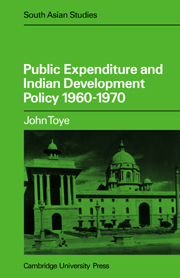10 - Summary of conclusions
from PART THREE - CONCLUSIONS
Published online by Cambridge University Press: 09 January 2010
Summary
Public expenditure is discussed by economists in a variety of different abstract frameworks. Wagner's ‘law of expanding state activity’, expressed as the functional dependence of the ratio of government spending to national income on per capita national income, correctly characterizes a feature of modern economic growth, but does little to explain that feature. As a theory of the long run, it is not susceptible to testing with medium-term empirical evidence. Peacock and Wiseman's public spending ‘displacement effect’ is not, pace K.N. Reddy, visible in Indian expenditure data, which is unsurpising since it is an abstraction from the U.K.'s social and economic history. Apart from these theories of the long run, economists view public spending from two other perspectives, one derived from microeconomics and the other from macroeconomics. The microeconomic perspective, explored in the literature on ‘public goods’, is a branch of welfare economics, so that attempts to use it for description or explanation are misconceived. The macroeconomic perspective leads to the building of macroeconomic models incorporating a disaggregated government sector. These models are intended to simulate the consequences of changes in fiscal policy. But the fiscal changes are themselves exogenous to the model, and thus inexplicable, apart from the fact that their consequences are worked out in a drastically simplified environment. Dissatisfaction with all these types of theorizing led in the 1960s to a proliferation of ultra-empirical public expenditure studies, hoping to produce inductive generalizations from the covariances detected by regression analysis.
- Type
- Chapter
- Information
- Public Expenditure and Indian Development Policy 1960–70 , pp. 234 - 244Publisher: Cambridge University PressPrint publication year: 1981

